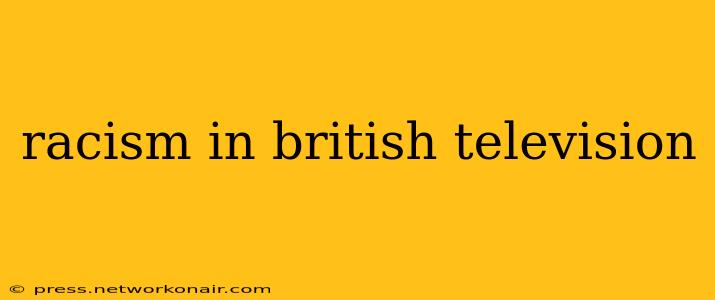British television, despite its global influence and reputation for quality programming, has a complex and often troubling history with racism. From subtle biases to overt displays of prejudice, representations of race and ethnicity have consistently reflected and, at times, exacerbated societal inequalities. This analysis explores the evolution of racism in British television, examining both historical portrayals and contemporary challenges.
What are some examples of racist stereotypes in British TV?
Historically, British television frequently relied on harmful stereotypes to depict people of color. Black characters were often relegated to roles as servants, criminals, or exotic “others,” perpetuating negative and dehumanizing tropes. Asian characters were frequently portrayed as submissive, hypersexualized, or comical, often playing into existing prejudices and reinforcing harmful narratives. These representations not only lacked depth and authenticity but also contributed to the marginalization and prejudice faced by these communities in real life. Even seemingly positive representations could perpetuate harmful stereotypes, such as the "magical negro" trope, where a Black character exists solely to help a white protagonist.
How has the representation of race and ethnicity changed on British TV over time?
While progress has been made, the journey towards equitable representation has been slow and uneven. The 1970s and 80s saw a gradual increase in the visibility of people of color on screen, but often within limited and stereotypical roles. The rise of multicultural Britain challenged the dominance of a solely white perspective, yet ingrained biases often persisted. The last few decades have witnessed a more concerted effort towards inclusivity, with more diverse casts and storylines becoming increasingly common. However, this progress is not uniform across all genres and networks, and significant challenges remain.
Has racism been addressed directly in British TV shows?
Some British television programs have directly addressed issues of racism, offering critical commentary and exploring the lived experiences of people of color. However, these shows are often exceptions rather than the rule, and the effectiveness of such representations can be debated. The challenge lies in creating authentic and nuanced portrayals that avoid tokenism and simplistic narratives, while also engaging a broad audience and sparking meaningful dialogue. The portrayal of racism should not simply be a plot device but should be explored with sensitivity and depth, accurately reflecting the complexities of racial discrimination.
What are the ongoing challenges in achieving truly diverse and inclusive representation on British TV?
Despite progress, significant hurdles remain in achieving genuine diversity and inclusion on British television. These include:
- Lack of diversity behind the camera: A lack of diversity in writing, directing, and producing roles means that the stories told often reflect the perspectives and experiences of a limited demographic.
- Tokenism: The inclusion of a single person of color in a cast doesn't necessarily equate to meaningful representation.
- Stereotypical portrayals: Even when people of color are featured prominently, they may still be confined to stereotypical roles that reinforce harmful biases.
- Limited opportunities: People of color often face significant barriers to entry and advancement within the television industry.
What is being done to address the issue of racism in British television?
There's a growing awareness of the need for greater diversity and inclusivity within the British television industry. This is leading to initiatives such as:
- Increased focus on diverse casting: Production companies are increasingly committed to casting a wider range of talent.
- Mentorship and training programs: Programs designed to support and develop talent from underrepresented groups are becoming more common.
- Industry-wide discussions and commitments: Conversations about diversity and inclusion are increasingly taking place at the highest levels of the industry.
However, meaningful change requires sustained effort and a fundamental shift in industry practices. It demands a commitment not just to ticking boxes, but to fostering a truly inclusive and equitable environment where diverse voices and perspectives can flourish. The fight against racism in British television is an ongoing process, requiring continuous vigilance and proactive measures to ensure that the screen truly reflects the richness and complexity of British society.

